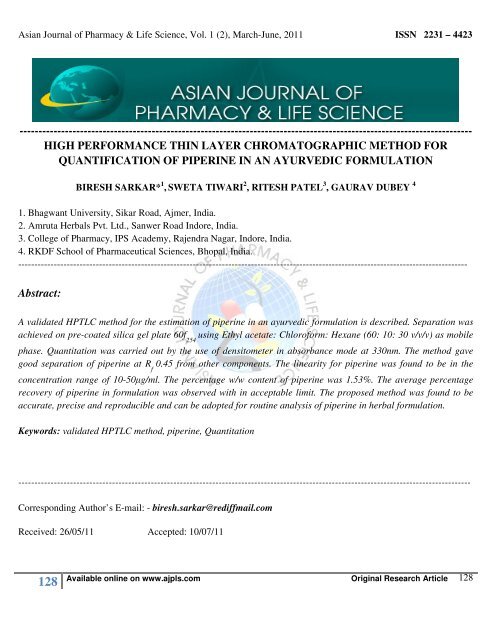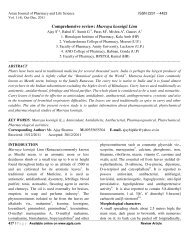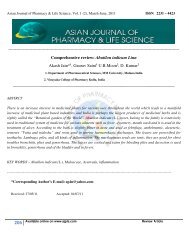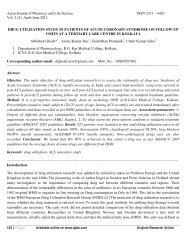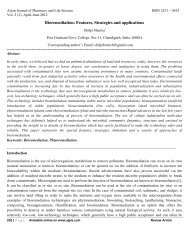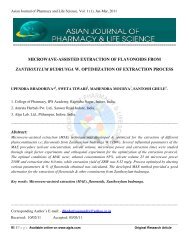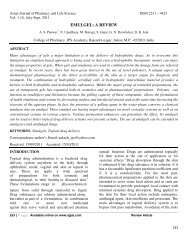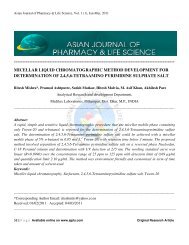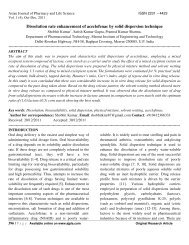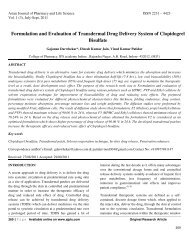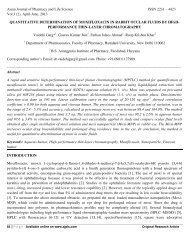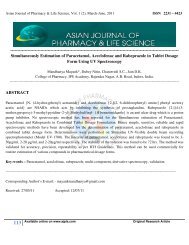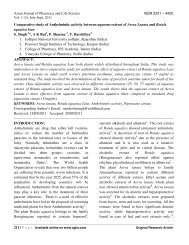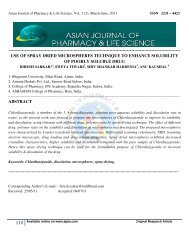high performance thin layer chromatographic method
high performance thin layer chromatographic method
high performance thin layer chromatographic method
You also want an ePaper? Increase the reach of your titles
YUMPU automatically turns print PDFs into web optimized ePapers that Google loves.
Asian Journal of Pharmacy & Life Science, Vol. 1 (2), March-June, 2011 ISSN 2231 – 4423------------------------------------------------------------------------------------------------------------------------HIGH PERFORMANCE THIN LAYER CHROMATOGRAPHIC METHOD FORQUANTIFICATION OF PIPERINE IN AN AYURVEDIC FORMULATIONBIRESH SARKAR* 1 , SWETA TIWARI 2 , RITESH PATEL 3 , GAURAV DUBEY 41. Bhagwant University, Sikar Road, Ajmer, India.2. Amruta Herbals Pvt. Ltd., Sanwer Road Indore, India.3. College of Pharmacy, IPS Academy, Rajendra Nagar, Indore, India.4. RKDF School of Pharmaceutical Sciences, Bhopal, India.-------------------------------------------------------------------------------------------------------------------------------------------Abstract:A validated HPTLC <strong>method</strong> for the estimation of piperine in an ayurvedic formulation is described. Separation wasachieved on pre-coated silica gel plate 60f 254using Ethyl acetate: Chloroform: Hexane (60: 10: 30 v/v/v) as mobilephase. Quantitation was carried out by the use of densitometer in absorbance mode at 330nm. The <strong>method</strong> gavegood separation of piperine at R f0.45 from other components. The linearity for piperine was found to be in theconcentration range of 10-50µg/ml. The percentage w/w content of piperine was 1.53%. The average percentagerecovery of piperine in formulation was observed with in acceptable limit. The proposed <strong>method</strong> was found to beaccurate, precise and reproducible and can be adopted for routine analysis of piperine in herbal formulation.Keywords: validated HPTLC <strong>method</strong>, piperine, Quantitation--------------------------------------------------------------------------------------------------------------------------------------------Corresponding Author’s E-mail: - biresh.sarkar@rediffmail.comReceived: 26/05/11 Accepted: 10/07/11128Available online on www.ajpls.com Original Research Article 128
Asian Journal of Pharmacy & Life Science, Vol. 1 (2), March-June, 2011 ISSN 2231 – 4423Fig. 2. HPTLC fingerprinting of Ajmodadi churna(peak showing piperine in sample formulation)Table 1% drug content & linearity of piperine by HPTLCParametersLinearity rangeTable-IISystem repeatability and precisionSampleConcentrationµg/mlIntra-daymeasuredconcentrationMean(µg/ml)%R.S. DInter-daymeasuredconcentrationMean(µg/ml)%R.S. D10 9.36 0.123 10.22 0.029130 28.36 0.098729.05 0.057450 49.23 0.102 50.41 0.1245Table-IIIRecovery studiesLevelAmount presentµg/ml% ofstandardAdditionRange10-50 µg/mlCorrelation coefficient (r) 0.9997% drug content 1.53%Rf0.45%Recovery180 99.75215.2100 98.153 120 98.18Conclusion:A simple, rapid and accurate HPTLC <strong>method</strong> for theestimation of piperine in Ajmodadi churna wasdeveloped which can be used as a valuable analyticaltool in routine analysis to check the batch to batchvariations. The <strong>method</strong> was showed excellentsensitivity, reproducibility, accuracy and repeatability,which is evidence by low percentage relative standarddeviation. Hence it is suggested that the proposedHPTLC <strong>method</strong> can be effectively used for the routineanalysis of piperine in Ajmodadi churna and its crudedrugs.References:1. Gilani AH, Rahman A. J. EthnoPharmacology, 2005; 100: 43- 49.2. WHO. Traditional Medicine Strategy,WorldHealth Organization; Geneva. 2002-2005.3. Zidorn C, Schubert B, Stuppner H, BiochemSys and Eco, 2005; 33: 855-72.4. Layloff T, Scientific Fingerprinting: APharmaceutical Regulatory ToolPharm.Technol, 1991; 15: 146-148.5. WHO, Guidelines for the Assessment ofHerbal Medicine, Munich, World HealthOrganization, 1991.6. CHMP, Guideline on Quality of HerbalMedicinal Products/Traditional HerbalMedicinal Products, Committee for MedicinalProducts for Human use, European MedicinesAgency Inspections, 2005.131Available online on www.ajpls.com Original Research Article 131
Asian Journal of Pharmacy & Life Science, Vol. 1 (2), March-June, 2011 ISSN 2231 – 44237. Welsh WJ, Lin WK, Tersigni SH, Collantes E,Duta R, Carey MS, Anal. Chem, 1996; 68:3473.8. The Ayurvedic Formulary of India, Part-I, II ndedition, New Delhi: Govt. of India, Ministry ofHealth and Family Planning, Depart of Health2003, 103-19.9. Touchstone J C., Practice of Thin LayerChromatography, USA: John Wiley & Sons;1992.10 Sherma J, Fried B. Handbook of Thin LayerChromatography. Chromatography ScienceSeries. New York: Marcel Dekker; 1996.11 Jardine AKS, Macfarlane, Green S. StatisticalMethods for Quality Control. UK: IBM Press;1975.12 Sethi PD, Charegaonkar D, Identification ofDrugs in Pharmaceutical Formulations byTLC. New Delhi: CBS Publishers; 1999.13 Stahl E. Thin Layer Chromatography ALaboratory Handbook. New Delhi: CBSPublishers; 1969.14 Khandelwal KR. Practical PharmacognosyTechniques and Experiments. 9 th edition, NewDelhi, Nirali Prakashan 2002; 152.15 Jain V, Saraf S, SpectrophotometricDetermination of Piperine in Trikatu Churna;an Ayurvedic Formulation, Asian J. of Chem2007; 19 (7):5331-5.132Available online on www.ajpls.com Original Research Article 132


